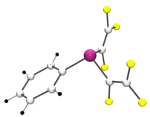Fluorine Chemistry Research
This is the Home Page of the fluorine research group in the School of Chemistry at The University of Manchester, formerly UMIST.
Fluorine Chemistry underpins all of our research work
Fluorine is one of the most reactive elements in the periodic table yet some of its compounds are the most stable and least reactive! Others are even more reactive than fluorine itself! It is the ability of fluorine to drastically alter the steric and electronic properties of its compounds that fascinates us.
Compounds of fluorine find applications in almost all areas of modern life. From fluoride in toothpaste to the many different fluorinated plastics and materials, from polytetrafluoroethene, PTFE (tradename Teflon) in "non-stick" pans to Gortex coats. Many modern pharmaceutical compounds (anti-cancer, antibiotics, anti-malerial etc) include fluorine, or fluorinated groups. The generation of the small organo-fluorine hydrofluorocarbons (HFCs) resulted in the rapid phaseout of their ozone-depleting cousins, CFCs.
Our research crosses the traditional inorganic and organic borders, some of it is curiousity driven and some has industrial relevance. Our main areas of research include the chemistry of HFCs, fluorophosphines, organofluorine compounds of main-group and transition metal elements applications of fluorinated materials, such as ionic liquids and fluorographene, and spectroscopy. Our Research Overview page provides a summary of all of these areas, while links are provided below for individual topics.
Fluorine chemistry methodology
The introduction of fluorine and fluorine-containing groups into molecules,
using inorganic fluorides, hydrofluorocarbons (HFCs, the replacements for CFCs)
such as HFC-134a (CF3CH2F) and HFC-245fa
(CF3CH2CHF2) and related methods.
Fluorine-containing phosphines
The synthesis of fluoroalkyl, fluoroalkenyl and fluoroalkynyl
fluorine-containing phosphines, their properties,
coordination complexes, uses and applications.
Fluoro-organometallics
Organofluorine compounds of main-group
and transition metal elements, their structures and chemistries
including catalysis, such as trifluorovinyl and trifluoropropynyl complexes.
Fluorine-containing materials
The synthesis of fluorine-containing functional materials, such as our work on polymer precursors,
fluorographene and room temperature ionic liquids (RTILs).
Publications
Full publication lists with links to the original papers, and downloadable ESI and
open access data.
Spectroscopy and Analysis Tools
Examples and theory behind multinuclear NMR spectroscopy,
on-line tools to calculate elemental (microanalysis) figures,
31-P nmr chemical shifts for phosphines,
J-coupling patterns,
mass spectrometry fragment patterns and our
spectroscopy database (19F, 31P and IR)
The group, past &
present
Details of current and former final year project students, MSc, PhD researchers
and visiting academics. Also how to join us
or find possible funding and the research facilities available.

![[Pt2(S)2(PPh3)4] as predicted by our mstool The calculated mass spectrum of [Pt2(S)2(PPh3)4]](/rotator/mstool.png)



